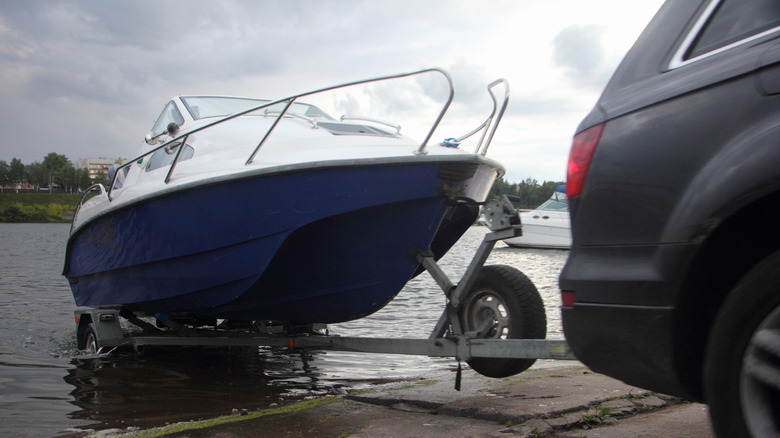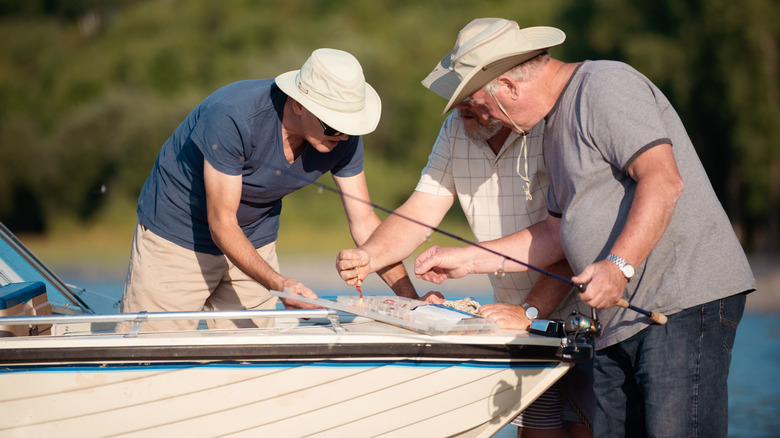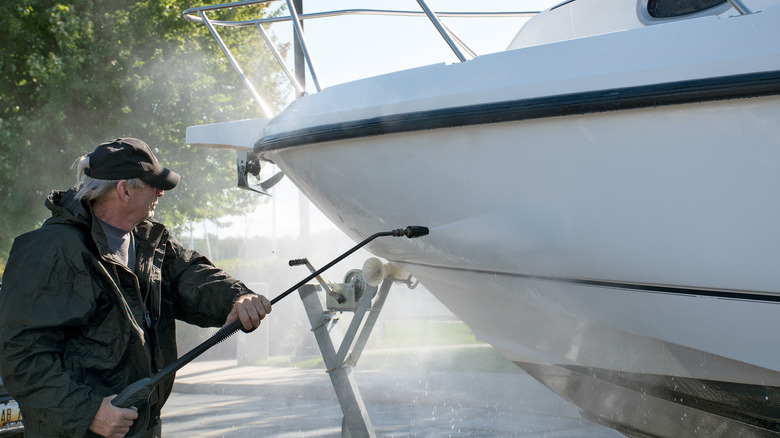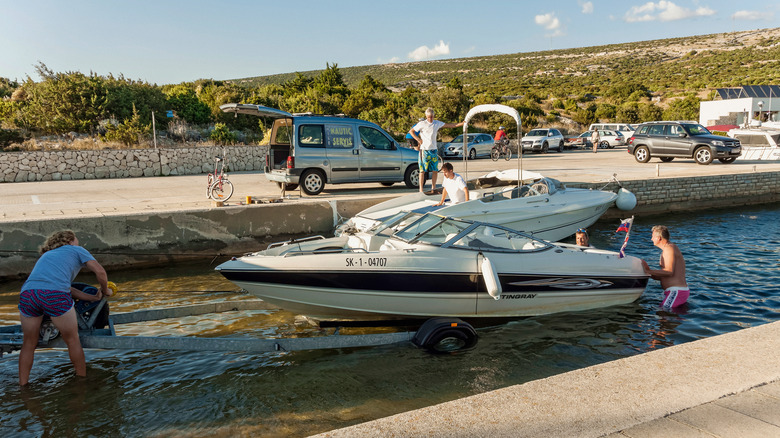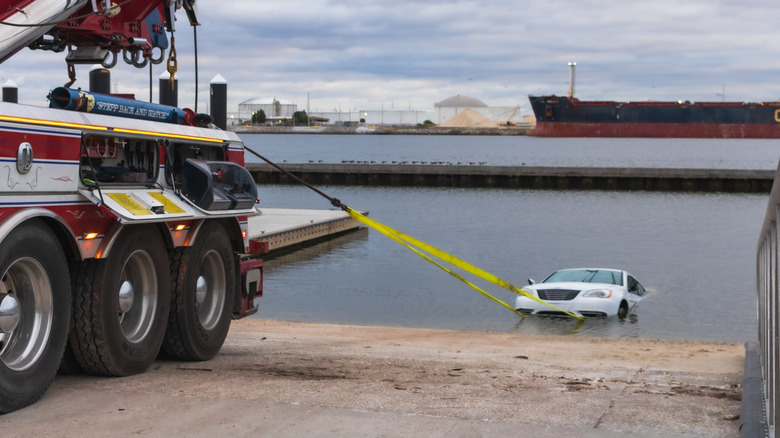5 Common Mistakes People Make When Launching Their Boat
Over a lifetime spent running boats, including a couple of decades as a professional fishing guide and boat captain, I have visited countless boat ramps, launching boats thousands of times. During that time, I've also witnessed a myriad of mistakes made while launching boats. Admittedly, I even made a few myself. While there seems to be an infinite amount of things that can go or be done wrong, there are a handful of mistakes that seem to be made repeatedly.
Some of the common mistakes people make when launching their boat are breaches of boat ramp etiquette — like using the ramp to load your boat — while others are actual safety issues — like dropping your trailer off the ramp. Regardless of which category they fall into, these are definitely things you want to avoid doing in order to have a safe, enjoyable day on the water and protect your boat and equipment from damage. The good news is all of these common mistakes people make when launching their boat are 100% avoidable.
Using the ramp to load your boat
The purpose of a boat ramp is to provide an access point to put a boat in the water. So, by the time you begin backing onto the ramp, your boat should be ready to go. This is not the time to be loading or organizing gear like fishing tackle, picnic supplies, or ski gear. Nor is it the time or place for preparing the boat for launching or for the ride home. Some ramp facilities have make-ready areas for the purpose of getting gear organized and the boat ready to launch. If your ramp does not have this, utilize the parking lot or other empty area outside of the ramp and backing lanes to attend to these tasks.
As a rule of thumb, it is best to have all boating safety equipment – including life jackets for kids and adults who will be on board — loaded and stowed before you even leave the house. The same goes with picnic, fishing, or watersport gear. If you are not comfortable towing the boat with your recreational equipment on board, load it in the boat at the make-ready spot or in the parking lot. Be sure you have your plugs in the boat and any extra safety straps removed before backing down the ramp.
The same applies when pulling your boat out of the water. Once you have your boat on the trailer, pull out of the ramp area and back into the parking lot or another empty space out of the way before unloading equipment from your boat or securing additional safety straps for the tow home.
Taking too long at the courtesy dock or wash down station
Boat launch facilities often have amenities such as courtesy docks and wash down stations. These niceties should be utilized, but taking too long at either can bog down the entire boat ramp procession. So, the key is to be as quick and efficient as possible, without sacrificing safety.
A courtesy dock is meant to serve two purposes: to either secure the boat while you load or unload passengers, or to secure the boat while you move the tow vehicle to the parking lot after launching or retrieve the tow vehicle for pulling the boat out of water. Once your boat is in the water, tie it to the courtesy dock and quickly move your tow vehicle out of the ramp and into the parking lot. Additional passengers should be unloaded before you back down the ramp so they are ready to get on the boat as soon as you pull to the courtesy dock.
Wash down stations at boat ramp facilities are not meant for conducting a deep clean, cleaning fishing gear, or other equipment maintenance. Rather, it is a spot to conduct a quick rinse and to remove any invasive species that could inadvertently be transported to another body of water. In saltwater environments, it can help to remove any salt buildup before it becomes too dry and embedded. Save the full wash and equipment rinse for when you get back home.
Launching a boat that won't start
A boat that won't start is a sure-fire way to ruin a day on the water. However, if your boat doesn't start at the ramp and it's already in the water, you can possibly ruin the day for those behind you in the boat ramp line as well.
The best way to prevent this is to maintain your boat and engine. When you have a trip planned, hook your engine to a hose with motor muffs and check to be sure it starts before leaving the house. You should also make sure your battery is in good shape and fully charged. Once you've backed down the ramp, make sure it starts before unhooking it from the winch strap. Even if you don't plan to drive it off the trailer, start it before pushing it off. If the boat is not starting, it shouldn't leave the trailer.
In the event the boat stalls or dies on the ramp and can't be restarted, you have a couple of options. If you can safely and quickly pull the boat back on the trailer using docks lines and the winch strap, do so. Then, pull out of the ramp and into the parking lot. If you are unable to get it back on the trailer in that manner, tie it up to the courtesy dock, pull your tow vehicle from the ramp, and allow others to launch before attempting to reload your boat. If possible, use dock lines to walk your boat further down the courtesy dock to leave plenty of room for others.
Damaging the boat, motor, or trailer
After you gone through all the hassle and expense of choosing the right boat, the last thing you want to do is destroy it. However, it is not uncommon to incur serious damage to your boat, motor, or trailer at the boat ramp. Lapses in concentration, focus, or judgment are typically to blame. So, the best way to avoid damaging your boat, motor, or trailer during the process of launching or loading is to be prepared, pay attention, and not get distracted.
One of the more common mistakes that lead to damage is forgetting to put the drain plugs in your boat before setting it in the water. If this mistake is caught while the boat is still on the trailer, it is possible to slowly pull it back out and allow the water to drain. However, if the boat is already off the trailer, it can lead to the boat capsizing or sinking.
There are other common issues, such as hitting the trailer wrong and messing up lights, the boat hull, fenders, or other parts. But, probably the second most common is damaging the motor's lower unit and/or propeller when it hits the pavement going down or coming up the ramp. To avoid this, raise your engine before backing down or pulling up the ramp. This can be done with the electric tilt and trim or jack plate. If your boat has neither, you can manually raise the engine and lock in a tilt position.
Dropping your tow vehicle or trailer off the ramp
One of the most catastrophic mistakes that can be made at a boat ramp is dropping your trailer, or worse, your entire rig into the water. Unfortunately, this happens more often than most people realize. There are a few things you can do, however, to ensure this doesn't happen to you. For starters, make sure your tow vehicle is capable of pulling your boat — and not just on flat road, but uphill on a wet ramp. Far too often, a boat that is too big for the tow vehicle can drag the entire rig down the inclined ramp and into the water. Even with an adequate tow vehicle, you need to know how far you can back down without falling off end or ramp. Some ramps have signs marking the end. Others, you need to determine where it ends for yourself. Either way, the best practice is to not back up further than necessary to get your boat off the trailer.
Because this type of accident can happen, either to yourself or someone else at a ramp you may be using, it is a good idea to carry a tow strap in your vehicle. If you do have to pull a submerged boat or vehicle from the water, let it drain before pulling it all the way up the ramp, as the extra weight of the water can cause additional damage once on land.
